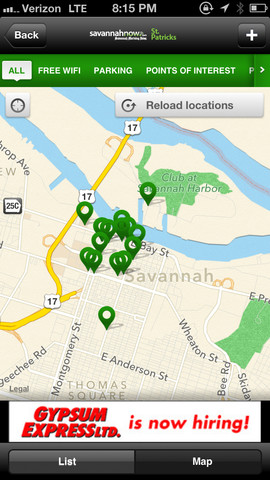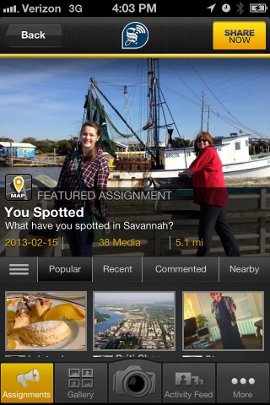
St. Patrick's Day app from Shoutem

Spotted app from Filemobile
I'm big on open standards. I use open-source software almost exclusively. I'm an advocate of HTML5 and responsive layout. And I'm not all that happy with vendors. I'm of the download-and-build persuasion.
So it's a little bit odd that I find myself with a bunch of mobile apps and a vendor-powered reboot of an old standard.
First, the apps.
Once a year, Savannah turns green with the second-largest St. Patrick's Day parade in the world. It's sort of like Mardi Gras in New Orleans, but with more Spanish moss and less beads. People come from all over the world to indulge in the weekend-long celebration.
They need practical info and communications tools, so we built a mobile app for iOS and Android that provides mapping, lists of critically important resources like ATMs and porta-potties, and supports both social conversation and push messaging.
This is a "disposable app" -- intended to live just for the moment, addressing a niche need.
Most of what it does can be done without an app. In fact, under the hood, it's mostly HTML5. But its "app" status gives it some advantages in distribution, push notifications, geolocation permissions, and revenue possibilities. (Advertisers respond to "app" more positively than "mobile website.")
As for vendors: It's built on Shoutem.com, a very affordable "Software As A Service" platform that Carl Lewis found. We "built it ourselves" by pointing and clicking and choosing from menus. SAAS solutions are in fact "cookie-cutter," but they're revolutionizing the world of software by providing self-serve tools that meet the majority of needs.
Now, for the "old standard."
Around 2004, we created a content-and-marketing program called Spotted. At its heart: Digital photographers go to public events, turn the camera on the audience, and hand out "you've been Spotted!" business cards. It's based on work in 1999-2000 when I was at Cox Interactive Media.
In 2005 we built it into the Augusta Chronicle and Bluffton Today websites, and expanded it into a user-contributed program, taking inspiration from Flickr. It was a huge hit with users and won awards from industry organizations. Software was written to support it, and that software became a product sold internationally by Morris Digitalworks.
But the world moved on. Image-sharing exploded on new platforms like Facebook and Instagram, while mdSpotted (the software) didn't keep pace.
Some months ago, Morris Publishing Group made a decision to move ahead with a new vendor, Toronto-based Filemobile, on a project code-named Shoebox. The idea was to focus on a database and an API so we could build completely new applications not yet envisioned. We could have coded it, or adapted Drupal to do it. But it turned out that Filemobile had already built pretty much what we had in mind, offered as a hosted service. Time to market is important.
And they were working on a mobile image-sharing community app. We're launching that app (iOS only) just in time for St. Patrick's Day.
The app advantage for photo-sharing is obvious -- HTML pages don't have access to many device capabilities, such as the camera. We can send push notifications of "assignments" to users, too.
We'll be rebuilding the Spotted website on the Filemobile platform, too, with an eventual goal of responsive layout and user-authentication integration with our Drupal systems. Much work remains to be done, so we're taking a few shortcuts for St. Patrick's Day.
We have an iPad app that's an enhanced replica of the printed newspaper (MediaSpectrum). We have an "e-edition" Web-based print replica (Olive). We have a mobile news app (Inergize). We have another niche app in the works. And of course we have mobile, desktop and responsive HTML websites.
I believe open standards, open tools and open source win in the long run, but we should offer choice to users.
